Halderman J.D., Linder J. Automotive Fuel and Emissions Control Systems
Подождите немного. Документ загружается.


FUEL-INJECTION COMPONENTS AND OPERATION 261
0
130
10 120
20 110
30 100
40
90
50 80
60 70
PSI
PRESSURE
GAUGE
TO MANIFOLD
VACUUM
SOURCE
PRESSURE
REGULATOR
INJECTORS
FUEL TANK
FUEL
FILTER
FUEL PUMP
INLET
STRAINER
RETURN
LINE
FIGURE 20–9 A typical port fuel-injected system showing a
vacuum-controlled fuel-pressure regulator.
NO VACUUM
APPLIED
VACUUM
APPLIED
46
PSI
36
PSI
BACK TO
FUEL TANK
BACK TO
FUEL TANK
FIGURE 20–10 A typical fuel-pressure regulator that has
a spring that exerts 46 pounds of force against the fuel.
If 20inches of vacuum are applied above the spring, the
vacuum reduces the force exerted by the spring on the fuel,
allowing the fuel to return to the tank at a lower pressure.
The pressure regulator and fuel pump work together to maintain
the required pressure drop at the injector tips. The fuel- pressure
regulator typically consists of a spring-loaded, diaphragm-
operated valve in a metal housing.
Fuel-pressure regulators on fuel-return-type fuel-injection
systems are installed on the return (downstream) side of the
injectors at the end of the fuel rail or are built into or mounted
upon the throttle-body housing. Downstream regulation mini-
mizes fuel-pressure pulsations caused by pressure drop across
the injectors as the nozzles open. It also ensures positive fuel
pressure at the injectors at all times and holds residual pressure
in the lines when the engine is off. On mechanical returnless sys-
tems, the regulator is located back at the tank with the fuel filter.
In order for excess fuel (about 80% to 90% of the fuel
delivered) to return to the tank, fuel pressure must overcome
spring pressure on the spring-loaded diaphragm to uncover the
return line to the tank. This happens when system pressure ex-
ceeds operating requirements. With TBI, the regulator is close
to the injector tip, so the regulator senses essentially the same
air pressure as the injector.
The pressure regulator used in a port fuel-injection system
has an intake manifold vacuum line connection on the regulator
vacuum chamber. This allows fuel pressure to be modulated by
a combination of spring pressure and manifold vacuum acting
on the diaphragm.
SEE FIGURES 20–9 AND 20–10 .
FUEL-PRESSURE
REGULATOR
Don’t Forget the Regulator
Some fuel-pressure regulators contain a 10-micron
filter. If this filter becomes clogged, a lack of fuel flow
would result.
SEE FIGURE 20–11 .
TECH TIP
FILTER SCREEN
FIGURE 20–11 A lack of fuel flow could be due to a re-
stricted fuel-pressure regulator. Notice the fine screen filter.
If this filter were to become clogged, higher-than-normal fuel
pressure would occur.
In both TBI and port fuel-injection systems, the regulator
shuts off the return line when the fuel pump is not running. This
maintains pressure at the injectors for easy restarting after hot
soak as well as reducing vapor lock.
262 CHAPTER 20
NOTE: Some General Motors throttle-body units do not
hold pressure and are called nonchecking .
Port fuel-injection systems generally operate with pres-
sures at the injector of about 30 to 55 PSI (207 to 379 kPa), while
TBI systems work with injector pressures of about 10 to 20 PSI
(69 to 138 kPa). The difference in system pressures results from
the difference in how the systems operate. Since injectors in a
TBI system inject the fuel into the airflow at the manifold inlet
(above the throttle), there is more time for atomization in the
manifold before the air-fuel charge reaches the intake valve.
This allows TBI injectors to work at lower pressures than injec-
tors used in a port system.
The primary reason why many port fuel-injected systems use
a vacuum-controlled fuel-pressure regulator is to ensure that
there is a constant pressure drop across the injectors. In a
throttle-body fuel-injection system, the injector squirts into
the atmospheric pressure regardless of the load on the en-
gine. In a port fuel-injected engine, however, the pressure in-
side the intake manifold changes as the load on the engine
increases.
VACUUM-BIASED FUEL-
PRESSURE REGULATOR
This system is unique because it does not use a mechanical
valve to regulate rail pressure. Fuel pressure at the rail is sensed
by a pressure transducer, which sends a low-level signal to a
controller. The controller contains logic to calculate a signal
to the pump power driver. The power driver contains a high-
current transistor that controls the pump speed using pulse
width modulation (PWM). This system is called the electronic
returnless fuel system (ERFS) .
SEE FIGURE 20–12 . This
ELECTRONIC RETURNLESS
FUEL SYSTEM
IN-LINE
FILTER
INJECTORS
FUEL
RAIL
F
U
EL TANK
FUEL
PUMP
FUEL-
TEMPERATURE
SENSOR
FUEL-
PRESSURE
SENSOR
B+
PCM
IC
IC
FUEL-PUMP
SPEED MODULE
12V
FIGURE 20–12 The fuel-pressure sensor and fuel-temperature sensor are often constructed together in one assembly to help
give the PCM the needed data to control the fuel-pump speed.
Engine Operating
Condition
Intake Manifold
Vacuum Fuel Pressure
Idle or cruise High Lower
Heavy load Low Higher
The computer can best calculate injector pulse width based
on all sensors if the pressure drop across the injector is the same
under all operating conditions. A vacuum-controlled fuel-pres-
sure regulator allows the equal pressure drop by reducing the
force exerted by the regulator spring at high vacuum (low-load
condition) yet allowing the full force of the regulator spring to be
exerted when the vacuum is low (high-engine-load condition).
FUEL-INJECTION COMPONENTS AND OPERATION 263
PRESSURE
SPRING
FUEL
FUEL
RETURN
TO TANK
FUEL RAIL
INJECTORS
IN-LINE FILTER
WITH INTERNAL
PRESSURE
REGULATOR
FUEL TANK
FUEL
PUMP
FIGURE 20–13 A mechanical returnless fuel system. The bypass regulator in the fuel filter controls fuel line pressure.
transducer can be differentially referenced to manifold pressure
for closed-loop feedback, correcting and maintaining the output
of the pump to a desired rail setting. This system is capable of
continuously varying rail pressure as a result of engine vacuum,
engine fuel demand, and fuel temperature (as sensed by an ex-
ternal temperature transducer, if necessary). A pressure vent
valve (PVV) is employed at the tank to relieve overpressure due
to thermal expansion of fuel. In addition, a supply-side bleed,
by means of an in-tank reservoir using a supply-side jet pump,
is necessary for proper pump operation.
The first production returnless systems employed the mechani-
cal returnless fuel system (MRFS) approach. This system has
a bypass regulator to control rail pressure that is located in
close proximity to the fuel tank. Fuel is sent by the in-tank pump
to a chassis-mounted inline filter with excess fuel returning to
the tank through a short return line.
SEE FIGURE 20–13 . The
inline filter may be mounted directly to the tank, thereby elimi-
nating the shortened return line. Supply pressure is regulated on
the downstream side of the inline filter to accommodate chang-
ing restrictions throughout the filter’s service life. This system
is limited to constant rail pressure (*CRP) system calibrations,
whereas with ERFS, the pressure transducer can be referenced
to atmospheric pressure for CRP systems or differentially refer-
enced to intake manifold pressure for constant differential injec-
tor pressure (**CIP) systems.
MECHANICAL RETURNLESS
FUEL SYSTEM
NOTE: *CRP is referenced to atmospheric pressure, has
lower operating pressure, and is desirable for calibra-
tions using speed/air density sensing. **CIP is refer-
enced to manifold pressure, varies rail pressure, and is
desirable in engines that use mass airflow sensing.
Given the experience with both ERFS and MRFS, a need was rec-
ognized to develop new returnless technologies that could com-
bine the speed control and constant injector pressure attributes
of ERFS together with the cost savings, simplicity, and reliability
of MRFS. This new technology also needed to address pulsation
dampening/hammering and fuel transient response. Therefore,
the demand delivery system (DDS) technology was developed.
A different form of demand pressure regulator has been applied
to the fuel rail. It mounts at the head or port entry and regulates
the pressure downstream at the injectors by admitting the pre-
cise quantity of fuel into the rail as consumed by the engine.
Having demand regulation at the rail improves pressure response
to flow transients and provides rail pulsation dampening. A fuel
pump and a low-cost, high-performance bypass regulator are
used within the appropriate fuel sender.
SEE FIGURE 20–14 .
They supply a pressure somewhat higher than the required rail
set pressure to accommodate dynamic line and filter pressure
losses. Electronic pump speed control is accomplished using a
smart regulator as an integral flow sensor. A pressure control
valve (PCV) may also be used and can readily reconfigure an
existing design fuel sender into a returnless sender.
DEMAND DELIVERY
SYSTEM
264 CHAPTER 20
IN-LINE
FILTER
INJECTORS
FUEL RAIL
FUEL TANK
FUEL
PUMP
PAPER
FILTER
RETURN
TO TANK
PRESSURE
SPRING
FIGURE 20–14 A demand delivery system uses a fuel pressure regulator attached to the fuel pump assembly.
Why Are Some Fuel Rails Rectangular Shaped?
A port fuel-injection system uses a pipe or tubes to de-
liver fuel from the fuel line to the intended fuel injectors.
This pipe or tube is called the fuel rail . Some vehicle
manufacturers construct the fuel rail in a rectangular
cross section.
SEE FIGURE 20–15 . The sides of the
fuel rail are able to move in and out slightly, thereby
acting as a fuel pulsator evening out the pressure
pulses created by the opening and closing of the injec-
tors to reduce underhood noise. A round cross-section
fuel rail is not able to deform, and as a result, some
manufacturers have had to use a separate dampener.
?
FREQUENTLY ASKED QUESTION
FUEL RAIL
FIGURE 20–15 A rectangular-shaped fuel rail is used to help
dampen fuel system pulsations and noise caused by the injec-
tors opening and closing.
FUEL INJECTORS
EFI systems use a 12 volt solenoid-operated injectors. SEE
FIGURE 20–16 . This electromagnetic device contains an arma-
ture and a spring-loaded needle valve or ball valve assembly.
When the computer energizes the solenoid, voltage is applied
to the solenoid coil until the current reaches a specified level.
This permits a quick pull-in of the armature during turn-on. The
armature is pulled off of its seat against spring force, allowing
fuel to flow through the inlet filter screen to the spray nozzle,
where it is sprayed in a pattern that varies with application.
SEE FIGURE 20–17 . The injector opens the same amount each
time it is energized, so the amount of fuel injected depends on the
length of time the injector remains open. By angling the director
hole plates, the injector sprays fuel more directly at the intake
valves, which further atomizes and vaporizes the fuel before it
enters the combustion chamber. PFI injectors typically are a top-
feed design in which fuel enters the top of the injector and passes
through its entire length to keep it cool before being injected.
Ford introduced two basic designs of deposit-resistant in-
jectors on some engines. The design, manufactured by Bosch,
uses a four-hole director/metering plate similar to that used by
the Rochester Multec injectors. The design manufactured by
Nippondenso uses an internal upstream orifice in the adjusting
tube. It also has a redesigned pintle/seat containing a wider tip
opening that tolerates deposit buildup without affecting injector
performance.
FUEL-INJECTION COMPONENTS AND OPERATION 265
FUEL RAIL
O-RING SEAL
ARMATURE
PINTLE PROTECTION
CASE
STAINLESS-
STEEL NEEDLE
PINTLE
ELECTRICAL
CONNECTOR
COIL
INTEGRAL FILTER
STAINLESS-
STEEL BODY
MANIFOLD
O-RING SEAL
FIGURE 20–16 A multiport fuel injector. Notice that the fuel
flows straight through and does not come in contact with the
coil windings.
FIGURE 20–17 Each of the eight injectors shown are producing
a correct spray pattern for the applications. While all throttle-body
injectors spray a conical pattern, most port fuel injections do not.
How Can the Proper Injector Size Be
Determined?
Most people want to increase the output of fuel to in-
crease engine performance. Injector sizing can some-
times be a challenge, especially if the size of injector
is not known. In most cases, manufacturers publish
the rating of injectors in pounds of fuel per hour (lb/hr).
The rate is figured with the injector held open at 3 bars
(43.5 PSI). An important consideration is that larger
flow injectors have a higher minimum flow rating. Here
is a formula to calculate injector sizing when changing
the mechanical characteristics of an engine:
Flow rate hp BSFC/# of cylinders maximum
duty cycle (% of on-time of the injectors)
• hp is the projected horsepower. Be realistic!
• BSFC is brake-specific fuel consumption in
pounds per horsepower-hour. Calculated values
are used for this, 0.4 to 0.8 pound. In most cases,
start on the low side for naturally aspirated engines
and the high side for engines with forced induction.
• # of cylinders is actually the number of injectors
being used.
• Maximum duty cycle is considered at 0.8 (80%).
Above this, the injector may overheat, lose con-
sistency, or not work at all.
An example follows:
5.7 liter V-8 240 hp 0.65/8 cylinders 8
24.37 lb/hr injectors required
?
FREQUENTLY ASKED QUESTION
FUEL
ATOMIZATION
NOZZLES
FUEL-
PRESSURE
REGULATOR
SINGLE
FUEL INJECTOR
FUEL
TUBES
FIGURE 20–18 A central port fuel-injection system.
CENTRAL PORT INJECTION
A cross between port fuel injection and throttle-body injec-
tion, CPI was introduced in the early 1990s by General Motors.
The CPI assembly consists of a single fuel injector, a pressure
regulator, and six poppet nozzle assemblies with nozzle tubes.
SEE FIGURE 20–18 . The central sequential fuel injection (CSFI)
system has six injectors in place of just one used on the CPI unit.
When the injector is energized, its armature lifts off of
the six fuel tube seats, and pressurized fuel flows through the
nozzle tubes to each poppet nozzle. The increased pressure
causes each poppet nozzle ball to also lift from its seat, allowing
fuel to flow from the nozzle. This hybrid injection system com-
bines the single injector of a TBI system with the equalized fuel
distribution of a PFI system. It eliminates the individual fuel rail
while allowing more efficient manifold tuning than is otherwise
possible with a TBI system. Newer versions use six individual
solenoids to fire one for each cylinder.
SEE FIGURE 20–19 .
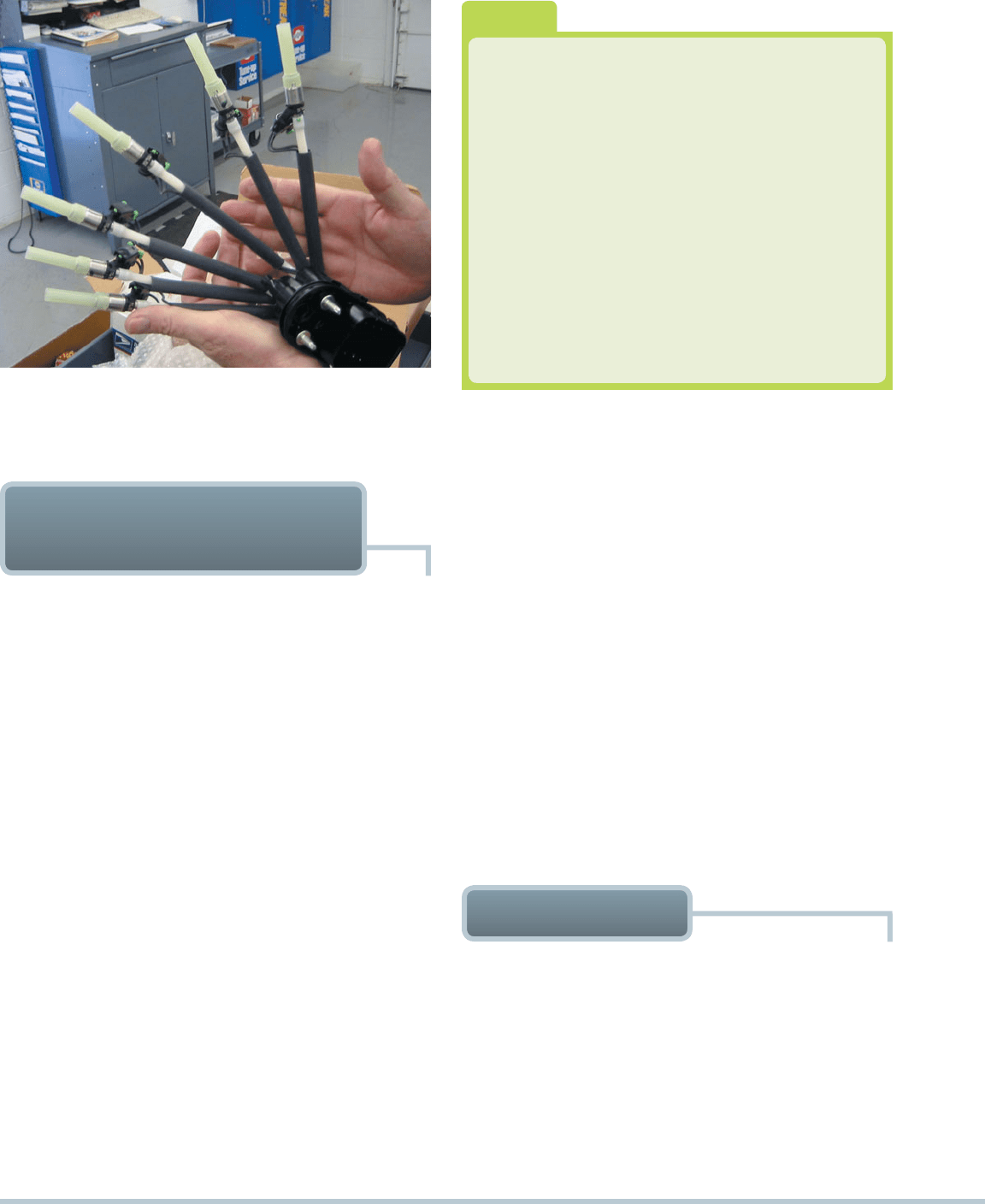
266 CHAPTER 20
FIGURE 20–19 A factory replacement unit for a CSFI unit
that has individual injectors at the ends that go into the intake
manifold instead of poppet valves.
All fuel-injection systems are designed to supply the correct
amount of fuel under a wide range of engine operating condi-
tions. These modes of operation include the following:
Starting (cranking) Acceleration enrichment
Clear flood Deceleration enleanment
Idle (run) Fuel shutoff
STARTING MODE When the ignition is turned to the start
position, the engine cranks, and the PCM energizes the fuel
pump relay. The PCM also pulses the injectors on, basing the
pulse width on engine speed and engine coolant temperature.
The colder the engine is, the greater the pulse width. Cranking
mode air-fuel ratio varies from about 1.5:1 at 40°F (40°C) to
14.7:1 at 200°F (93°C).
CLEAR FLOOD MODE If the engine becomes flooded with
too much fuel, the driver can depress the accelerator pedal to
greater than 80% to enter the clear flood mode. When the PCM
detects that the engine speed is low (usually below 600 RPM)
and the throttle-position (TP) sensor voltage is high (WOT), the
injector pulse width is greatly reduced or even shut off entirely,
depending on the vehicle.
OPEN-LOOP MODE Open-loop operation occurs during
warm-up before the oxygen sensor can supply accurate infor-
mation to the PCM. The PCM determines injector pulse width
based on values from the MAF, MAP, TP, ECT, and IAT sensors.
FUEL-INJECTION MODES
OF OPERATION
What Is Battery Voltage Correction?
Battery voltage correction is a program built into the
PCM that causes the injector pulse width to increase
if there is a drop in electrical system voltage. Lower
battery voltage would cause the fuel injectors to
open slower than normal and the fuel pump to run
slower. Both of these conditions can cause the en-
gine to run leaner than normal if the battery voltage
is low. Because a lean air-fuel mixture can cause the
engine to overheat, the PCM compensates for the
lower voltage by adding a percentage to the injector
pulse width. This richer condition will help prevent
serious engine damage. The idle speed is also in-
creased to turn the alternator faster if low battery
voltage is detected.
?
FREQUENTLY ASKED QUESTION
CLOSED-LOOP MODE Closed-loop operation is used to
modify the base injector pulse width as determined by feedback
from the oxygen sensor to achieve proper fuel control.
ACCELERATION ENRICHMENT MODE During accel-
eration, the throttle-position (TP) voltage increases, indicating
that a richer air-fuel mixture is required. The PCM then supplies
a longer injector pulse width and may even supply extra pulses
to supply the needed fuel for acceleration.
DECELERATION ENLEANMENT MODE When the engine
decelerates, a leaner air-fuel mixture is required to help reduce
emissions and to prevent deceleration backfire. If the deceleration
is rapid, the injector may be shut off entirely for a short time and
then pulsed on enough to keep the engine running.
FUEL SHUTOFF MODE Besides shutting off fuel entirely
during periods of rapid deceleration, PCM also shuts off the
injector when the ignition is turned off to prevent the engine
from continuing to run.
IDLE CONTROL
Port fuel-injection systems generally use an auxiliary air bypass
to control idle speed.
SEE FIGURE 20–20 . This air bypass
or regulator provides needed additional airflow and thus more
fuel. The engine needs more power when cold to maintain its
normal idle speed to overcome the increased friction from cold
lubricating oil. It does this by opening an intake air passage to
let more air into the engine just as depressing the accelerator
pedal would open the throttle valve, allowing more air into the
engine. The system is calibrated to maintain engine idle speed
at a specified value regardless of engine temperature.
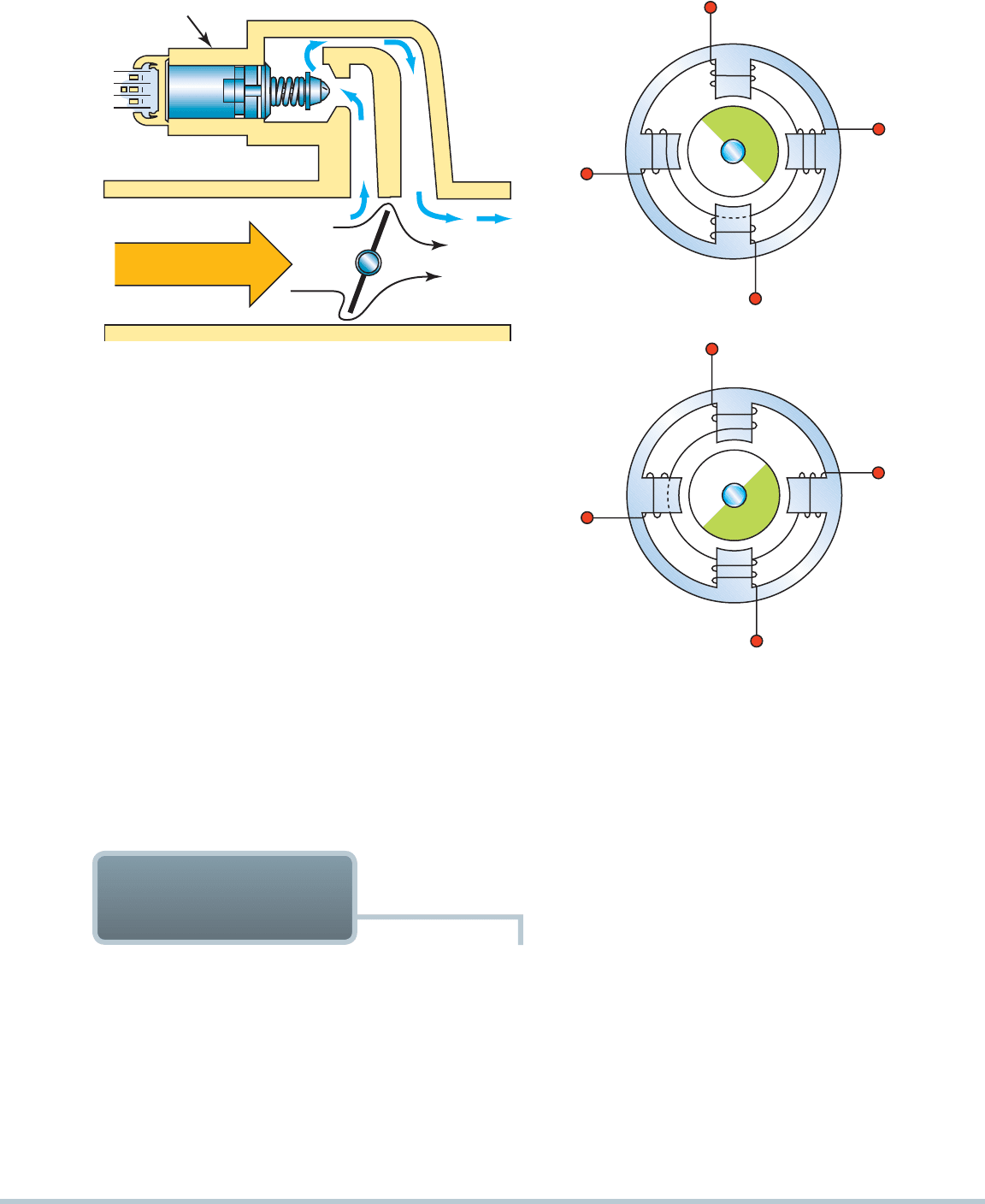
FUEL-INJECTION COMPONENTS AND OPERATION 267
Idle air control (IAC)
AIR INLET
FIGURE 20–20 The small arrows indicate the air bypass-
ing the throttle plate in the closed throttle position. This air
is called minimum air. The air flowing through the IAC (blue
arrows) is the airflow that determines the idle speed.
A digital output is used to control stepper motors. Stepper motors
are direct-current motors that move in fixed steps or increments
from deenergized (no voltage) to fully energized (full voltage). A
stepper motor often has as many as 120 steps of motion.
A common use for stepper motors is as an idle air con-
trol (IAC) valve, which controls engine idle speeds and prevents
stalls due to changes in engine load. When used as an IAC, the
stepper motor is usually a reversible DC motor that moves in
increments, or steps. The motor moves a shaft back and forth to
operate a conical valve. When the conical valve is moved back,
STEPPER MOTOR
OPERATION
N
N S
S
S
N
S
N
S
N
S
N
STEP 1
STEP 2
FIGURE 20–21 Most stepper motors use four wires, which
are pulsed by the computer to rotate the armature in steps.
Most PFI systems use an idle air control (IAC) motor to
regulate idle bypass air. The IAC is computer controlled and is
either a solenoid-operated valve or a stepper motor that regu-
lates the airflow around the throttle. The idle air control valve is
also called an electronic air control (EAC) valve.
When the engine stops, most IAC units will retract out-
ward to get ready for the next engine start. When the engine
starts, the engine speed is high to provide for proper operation
when the engine is cold. Then, as the engine gets warmer, the
computer reduces engine idle speed gradually by reducing the
number of counts or steps commanded by the IAC.
When the engine is warm and restarted, the idle speed
should momentarily increase, then decrease to normal idle
speed. This increase and then decrease in engine speed is often
called an engine flare . If the engine speed does not flare, then
the IAC may not be working (it may be stuck in one position).
more air bypasses the throttle plates and enters the engine,
increasing idle speed. As the conical valve moves inward, the
idle speed decreases.
When using a stepper motor that is controlled by the PCM,
it is very easy for the PCM to keep track of the position of the
stepper motor. By counting the number of steps that have been
sent to the stepper motor, the PCM can determine the relative
position of the stepper motor. While the PCM does not actually
receive a feedback signal from the stepper motor, it does know
how many steps forward or backward the motor should have
moved.
A typical stepper motor uses a permanent magnet and
two electromagnets. Each of the two electromagnetic wind-
ings is controlled by the computer. The computer pulses the
windings and changes the polarity of the windings to cause the
armature of the stepper motor to rotate 90 degrees at a time.
Each 90-degree pulse is recorded by the computer as a “count”
or “step,” thus the name given to this type of motor.
SEE
FIGURE 20–21 .
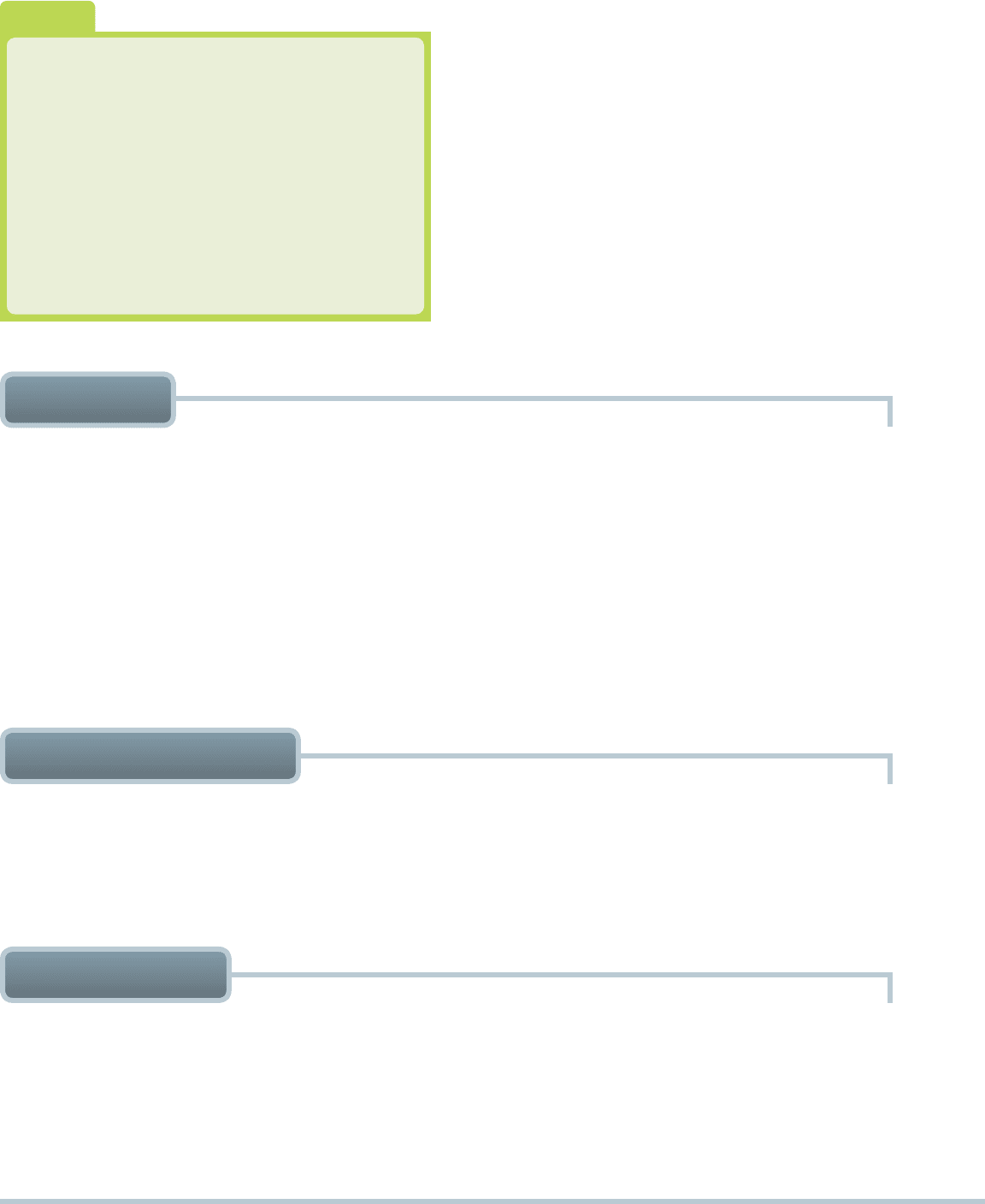
268 CHAPTER 20
Idle airflow in a TBI system travels through a passage
around the throttle and is controlled by a stepper motor. In
some applications, an externally mounted permanent magnet
motor called the idle speed control (ISC) motor mechanically
advances the throttle linkage to advance the throttle opening.
Why Does the Idle Air Control Valve
Use Milliamperes?
Some Chrysler vehicles, such as the Dodge minivan,
use linear solenoid idle air control (LSIAC) valves.
The PCM uses regulated current flow through the so-
lenoid to control idle speed and the scan tool display
is in milliamperes (mA):
Closed position 180 to 200 mA
Idle 300 to 450 mA
Light cruise 500 to 700 mA
Fully open 900 to 950 mA
?
FREQUENTLY ASKED QUESTION
4. How many sensors are used to determine the base pulse
width on a mass airflow system?
5. What are the three types of returnless fuel-injection
systems?
1. What are the two basic types of fuel-injection systems?
2. What is the purpose of the vacuum-controlled (biased)
fuel-pressure regulator?
3. How many sensors are used to determine the base pulse
width on a speed-density system?
REVIEW QUESTIONS
2. Why are some fuel rails rectangular in shape?
a. Increases fuel pressure
b. Helps keep air out of the injectors
c. Reduces noise
d. Increases the speed of the fuel through the fuel rail
1. Technician A says that the fuel-pump relay is usually con-
trolled by the PCM. Technician B says that a TBI injector
squirts fuel above the throttle plate. Which technician is
correct?
a. Technician A only
b. Technician B only
c. Both Technicians A and B
d. Neither Technician A nor B
CHAPTER QUIZ
5. The fuel-pressure regulator is usually located on the fuel
return on return-type fuel-injection systems.
6. TBI-type fuel-injection systems do not use a vacuum-
controlled fuel-pressure regulator, whereas many port
fuel-injection systems use a vacuum-controlled regulator
to monitor equal pressure drop across the injectors.
7. Other fuel designs include the electronic returnless, the
mechanical returnless, and the demand delivery systems.
1. A fuel-injection system includes the electric fuel pump and
fuel pump relay, fuel-pressure regulator, and fuel injectors
(nozzles).
2. The two types of fuel-injection systems are the throttle-
body design and the port fuel-injection design.
3. The two methods of fuel-injection control are the speed-
density system, which uses the MAP to measure the load on
the engine, and the mass airflow, which uses the MAF sensor
to directly measure the amount of air entering the engine.
4. The amount of fuel supplied by fuel injectors is determined
by how long they are kept open. This opening time is called
the pulse width and is measured in milliseconds.
SUMMARY

FUEL-INJECTION COMPONENTS AND OPERATION 269
7. Which type of port fuel-injection system uses a fuel-
temperature and/or fuel-pressure sensor?
a. All port fuel-injected engines
b. TBI units only
c. Electronic returnless systems
d. Demand delivery systems
8. Dampeners are used on some fuel rails to ______________ .
a. Increase the fuel pressure in the rail
b. Reduce (decrease) the fuel pressure in the rail
c. Reduce noise
d. Trap dirt and keep it away from the injectors
9. Where is the fuel-pressure regulator located on a vacuum-
biased port fuel-injection system?
a. In the tank
b. At the inlet of the fuel rail
c. At the outlet of the fuel rail
d. Near or on the fuel filter
10. What type of device is used in a typical idle air control?
a. DC motor
b. Stepper motor
c. Pulsator-type actuator
d. Solenoid
3. Which fuel-injection system uses the MAP sensor as the
primary sensor to determine the base pulse width?
a. Speed density
b. Mass airflow
c. Demand delivery
d. Mechanical returnless
4. Why is a vacuum line attached to a fuel-pressure regulator
on many port fuel-injected engines?
a. To draw fuel back into the intake manifold through the
vacuum hose
b. To create an equal pressure drop across the injectors
c. To raise the fuel pressure at idle
d. To lower the fuel pressure under heavy engine load
conditions to help improve fuel economy
5. Which sensor has the greatest influence on injector pulse
width besides the MAF sensor?
a. IAT c. ECT
b. BARO d. TP
6. Technician A says that the port fuel-injection injectors op-
erate using 5 volts from the computer. Technician B says
that sequential fuel injectors all use a different wire color
on the injectors. Which technician is correct?
a. Technician A only
b. Technician B only
c. Both Technicians A and B
d. Neither Technician A nor B
270 CHAPTER 21
Several vehicle manufacturers such as Audi, Mitsubishi,
Mercedes, BMW, Toyota/Lexus, Mazda, Ford, and General
Motors are using gasoline direct-injection (GDI) systems,
which General Motors refers to as a spark ignition direct
injection (SIDI) system. A direct-injection system sprays high-
pressure fuel, up to 2,900 PSI, into the combustion chamber as
the piston approaches the top of the compression stroke. With
the combination of high-pressure swirl injectors and modified
combustion chamber, almost instantaneous vaporization of the
fuel occurs. This, combined with a higher compression ratio,
allows a direct-injected engine to operate using a leaner-than-
normal air-fuel ratio, which results in improved fuel economy
with higher power output and reduced exhaust emissions.
SEE FIGURE 21–1 .
ADVANTAGES OF GDI The use of direct injection com-
pared with port fuel injection has many advantages, including
the following:
Improved fuel economy due to reduced pumping losses
and heat loss
Allows a higher compression ratio for higher engine
efficiency
Allows the use of lower-octane gasoline
The volumetric efficiency is higher
Less need for extra fuel for acceleration
Improved cold starting and throttle response
Allows the use of higher percentage of EGR to reduce
exhaust emissions
Up to 25% improvement in fuel economy
12% to 15% reduction in exhaust emissions
DISADVANTAGES OF GDI
Higher cost due to high-pressure pump and injectors
More components compared with port fuel injection
Because of the high compression, a NO
X
storage catalyst
is sometimes required to meet emission standards, espe-
cially in Europe. (
SEE FIGURE 21–2 )
Uses up to six operating modes, depending on engine
load and speed, which requires more calculations to be
performed by the powertrain control module (PCM).
DIRECT FUEL INJECTION
FIGURE 21–1 A gasoline direct-injection (GDI) system
injectsfuel under high pressure directly into the combustion
chamber.
chapter
GASOLINE
DIRECT-INJECTION
SYSTEMS
21
OBJECTIVES: After studying Chapter 21 , the reader should be able to: • Prepare for the ASE Engine Performance (A8)
certification test content area “C” (Fuel, Air Induction, and Exhaust Systems Diagnosis). • Describe the differences between port
fuel-injection and gasoline direct-injection systems. • List the various modes of operation of a gasoline direct-injection system.
• Explain how a gasoline direct-injection system works. • Perform a visual inspection of the gasoline direct-injection system and
identify the parts.
KEY TERMS : Gasoline direct injection (GDI) 270 • Homogeneous mode 272 • Spark ignition direct injection (SIDI) 270
• Stratified mode 272
